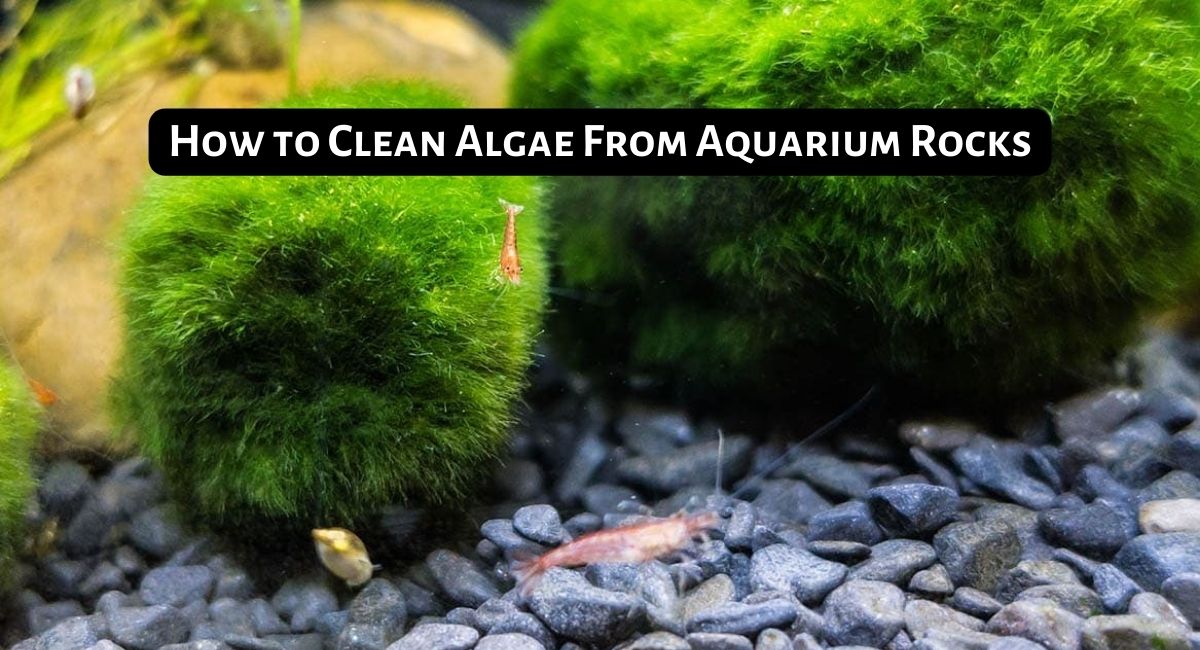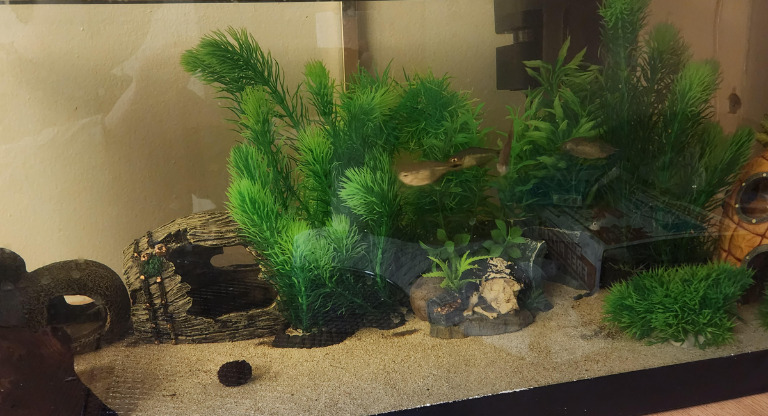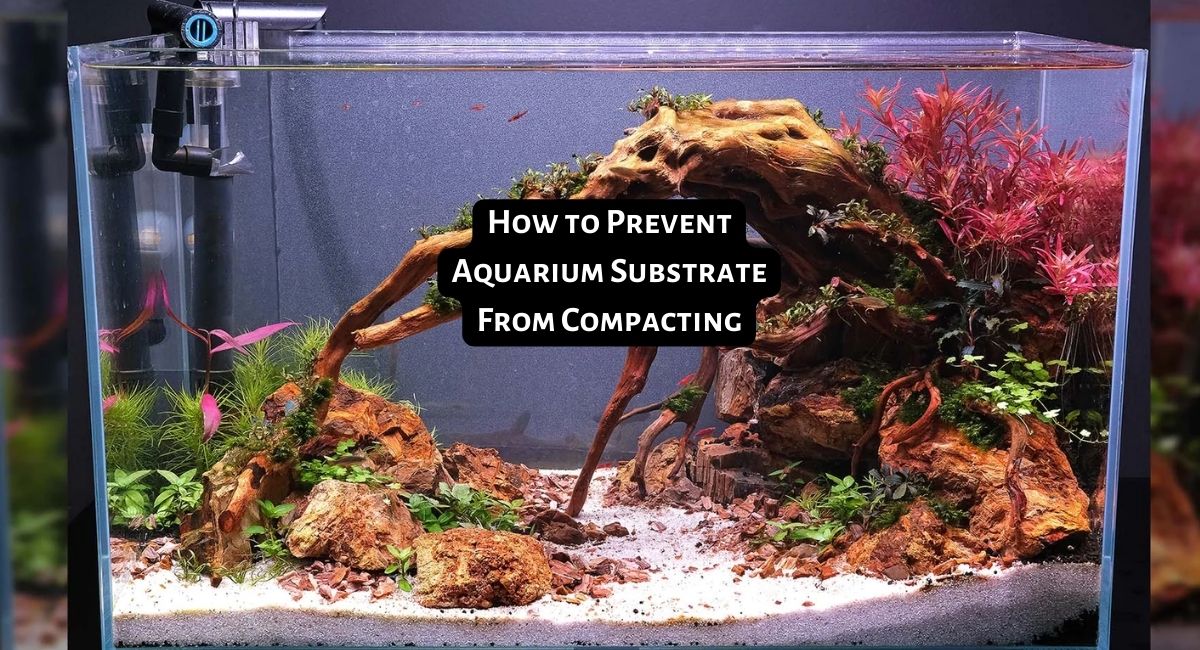Smartplantedaquarium.com participates in affiliate marketing programs. We may earn commissions on purchases made through our affiliate links. This doesn't affect our content or recommendations and we only recommend products we would put in our own tanks.
Creating and maintaining a vibrant aquatic environment within your aquarium is a rewarding experience for any fish or plant enthusiast. As any seasoned aquarist knows, the presence of unsightly algae on your carefully arranged aquarium rocks can detract from the beauty of your underwater world. In this article, We’ll delve into the step-by-step guide on how to clean algae from aquarium rocks.
Contents
Key Takeaways
- Algae growth on aquarium rocks is a common issue for aquarists.
- There are three proven methods to clean algae from aquarium rocks: using bleach, vinegar, or hydrogen peroxide.
- When using bleach, create a bleach solution, soak the rocks, scrub them, rinse thoroughly, air dry, and conduct a sniff test before returning them to the aquarium.
- When using vinegar, create a vinegar solution, soak the rocks, scrub them, rinse thoroughly, dry them, and reintroduce them to the aquarium.
- When using hydrogen peroxide, apply it directly to the rocks or soak them in a hydrogen peroxide solution, rinse thoroughly, and return them to the aquarium.
- Algae blooms can be caused by excess nutrients, poor water quality, inadequate light or CO2 levels, and the introduction of algae spores.
- Excessive algae growth can harm the aesthetics and health of the aquarium, including reduced oxygen levels, hindering plant growth, disrupting nutrient balance, producing toxins, and causing other issues.
- Removing fish from the tank while cleaning algae is generally unnecessary, but precautions may be necessary for certain methods or equipment.
- It is recommended to clean algae from aquarium rocks at least once a month.
- Boiling rocks is not recommended for killing algae.
- To remove brown algae from rocks, scrub them gently and rinse thoroughly, while also managing light and water parameters to prevent reoccurrence.
- To clean new aquarium rocks, rinse them multiple times with tap water and consider soaking them in a dechlorinator mixture before introducing them to the aquarium.
- Regular monitoring, appropriate lighting, nutrient management, and proper maintenance practices are key to controlling algae growth on aquarium rocks.
3 Proven Methods to Clean Algae From Aquarium Rocks
Cleaning algae from aquarium rocks is a common challenge faced by aquarists. Over time, these unsightly green patches can increase, compromising the aesthetics of your aquatic haven and potentially affecting the health of your tank’s inhabitants.
While some algae presence can be beneficial, providing food for certain fish and shrimp, an overabundance can signal an imbalance in the tank’s ecosystem. Addressing this concern, here are three proven methods to effectively cleanse your aquarium rocks of algae, ensuring a pristine and healthy environment for your aquatic pets.
How to Clean Aquarium Rocks of Algae Using Bleach
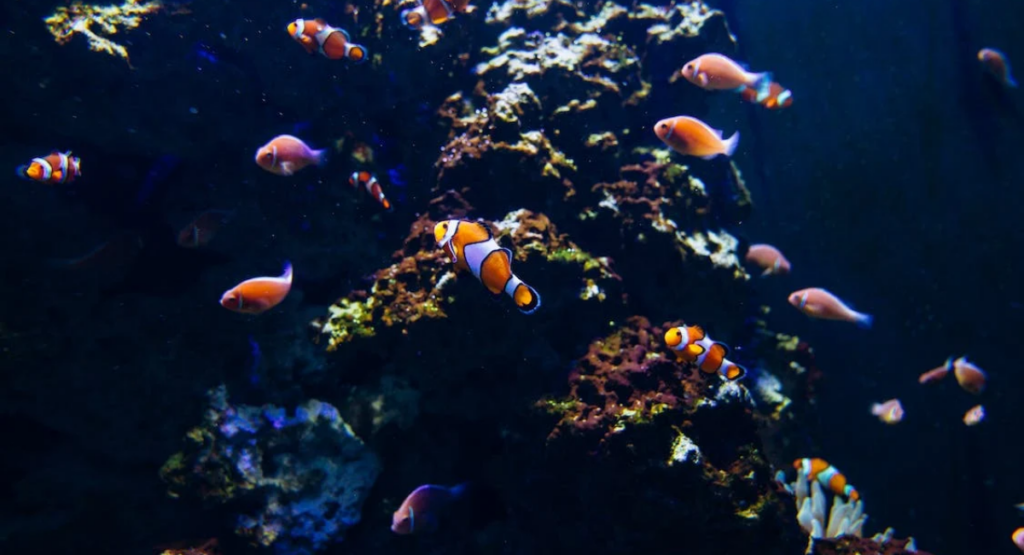
Cleaning aquarium rocks of algae using bleach is an effective method, but you must be very careful. Any residual bleach can harm your fish and plants. Here’s a step-by-step guide on how to do it:
- Prepare a bleach solution: Mix a bleach solution with a ratio of one part bleach to ten parts water. For instance, if you’re using one cup of bleach, mix it with ten cups of water. Always wear gloves and work in a well-ventilated area when handling bleach.
- Soak the rocks: Place the rocks in the bleach solution and let them soak for about 15-20 minutes. This should help to kill off the algae and disinfect the rocks.
- Scrub the rocks: After soaking, use a brush (an old toothbrush works well) to scrub away any remaining algae. Be sure to scrub all crevices and sides of the rock.
- Rinse thoroughly: This is the most crucial step. Rinse the rocks several times in clean, dechlorinated water to ensure that all bleach residue is removed. If you have a dechlorinator (a chemical used to neutralize chlorine), you can use it to help remove the bleach residues.
- Let the rocks air dry: Allow the rocks to air dry completely. This will help to ensure that any remaining bleach is broken down and evaporated.
- Conduct a sniff test: Before placing the rocks back into the aquarium, give them a sniff. If they still smell like bleach, rinse them again. It’s essential to ensure there’s no bleach smell before reintroducing them into your aquarium.
- Return the rocks to the aquarium: Once you are sure the rocks are free of bleach residue, you can place them back into the aquarium.

API MARINE ALGAEFIX Algae Control 16-Ounce Bottle (387D)
- Brand: API
- Liquid Volume: 16 Fluid Ounces
- Item Weight: 0.2 Pounds
- Item Form: Liquid
- Target Species: Fish, Shrimp
How to Remove Algae From Aquarium Rocks Using Vinegar
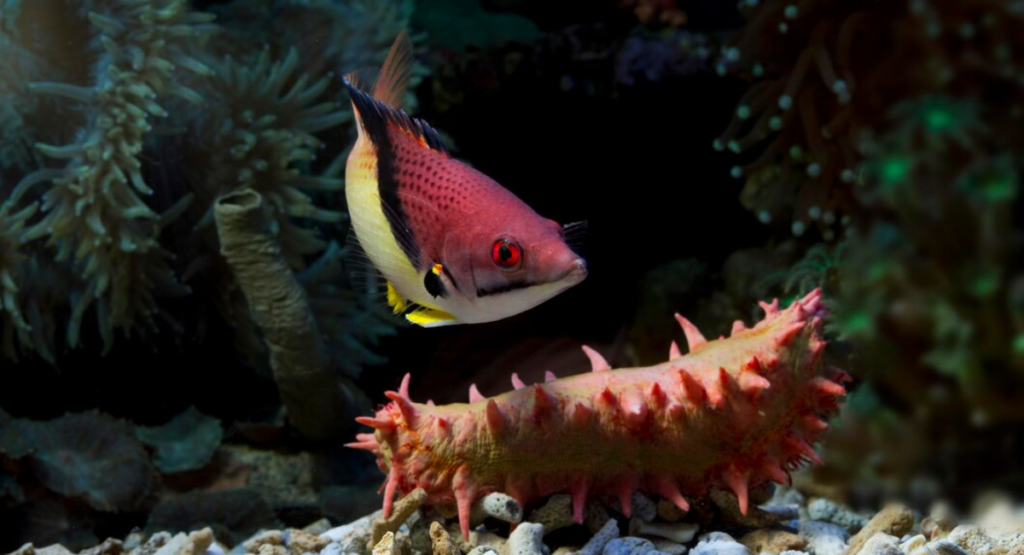
Removing algae from aquarium rocks using vinegar is a popular and relatively safe method. Here’s a step-by-step guide on how to do it:
- Preparation: Remove the fish and any other living organisms from the aquarium to ensure their safety. Remove the rocks and other decorations that have algae growth. Prepare a solution of equal parts white vinegar and water. For example, if you’re using 1 cup of vinegar, mix it with 1 cup of water.
- Soaking: Place the rocks in the vinegar solution. Make sure they are fully submerged. Allow the rocks to soak for about 20 to 30 minutes. This will help loosen the algae from the rocks.
- Scrubbing: After soaking, take a soft-bristle brush or an old toothbrush and gently scrub the rocks to remove the algae. Be gentle to avoid damaging the rocks. If there are stubborn algae spots, you can apply a bit of pure vinegar directly to the area and scrub.
- Rinsing: Thoroughly rinse the rocks with fresh water to remove any vinegar residue. It’s very important to ensure all the vinegar is rinsed off, as even small amounts can harm your fish and plants when reintroduced to the aquarium. You can rinse the rocks multiple times to be sure.
- Drying: Allow the rocks to air dry completely. This will further ensure that all the vinegar has evaporated.
- Reintroduction: Once the rocks are dry, you can place them back in the aquarium. Refill the aquarium with water and ensure the water conditions are safe (e.g., appropriate pH, temperature, and so on) before reintroducing the fish and other organisms.

Cleanaroo 75% Concentration Vinegar, All-Natural Multipurpose General Cleaner (32 oz)
- Brand: Cleanaroo
- Item Form: Spray
- Specific Uses For Product:Sink
- Material Feature:Natural
- Item Volume: 947 Milliliters
How to Remove Green Algae From Aquarium Rocks With Hydrogen Peroxide
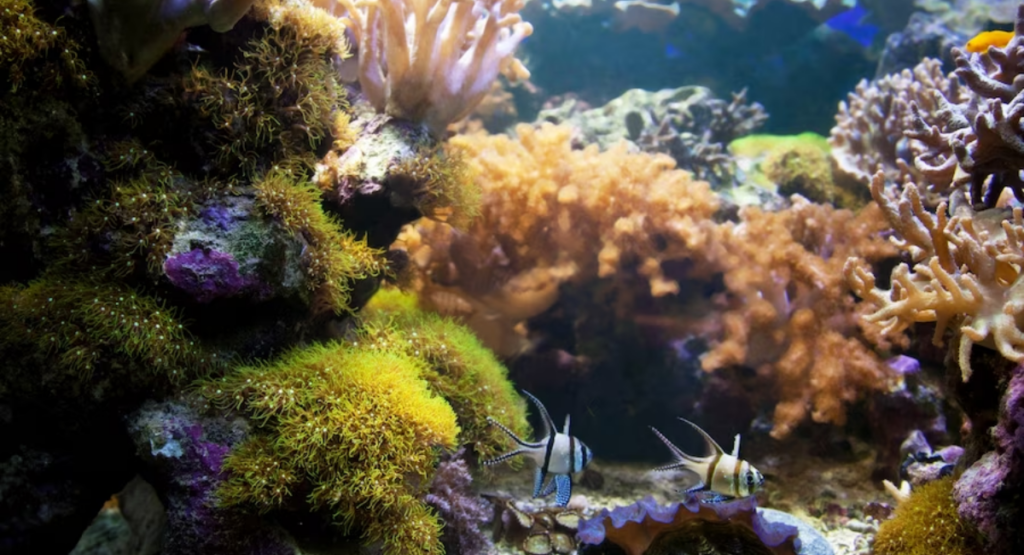
Hydrogen peroxide can be an effective method to remove green algae from aquarium rocks, but it should be used with caution. Too much hydrogen peroxide can be harmful to your fish and plants. Here’s a step-by-step guide:
- Apply Hydrogen Peroxide: Dip the brush or toothbrush into the hydrogen peroxide solution and scrub the rocks, focusing on areas with green algae. This method is useful for targeting specific areas.
- Soaking: If the algae is widespread, you can soak the entire rock in a solution of hydrogen peroxide. Mix 3 parts water with 1 part 3% hydrogen peroxide in a container. Place the rocks in the solution for no more than 5 minutes. Do not leave the rocks in the solution for too long, as excessive exposure can harm beneficial bacteria on the rocks.
- Rinse Thoroughly: After treating the rocks, rinse them several times with dechlorinated tap water or some of the aquarium water to ensure that all hydrogen peroxide residues are removed.
- Return to the Aquarium: Once you are sure the rocks are free of hydrogen peroxide, you can place them back into the aquarium.

SLSON Aquarium Algae Scraper Double Sided ,15.4 inches
- Product Dimensions : 15.4 x 3 x 1.4 inches; 1.45 Ounces
- Date First Available : May 26, 2018
- Manufacturer : SLSON
- ASIN : B07DC2TZCJ
Causes of Algae Blooms
Algal blooms are a common concern among aquarium enthusiasts. While some algae can benefit the ecosystem, excessive growth, or algal blooms, can harm the aesthetics and health of the aquarium. These blooms are primarily triggered by an excess of nutrients like nitrogen and phosphorus, often stemming from overfeeding, decaying plant matter, or fish waste. Inadequate water quality due to infrequent changes and poor filtration can exacerbate the issue.
Excessive light exposure, low plant density, insufficient CO2 levels for aquatic plants, poor water circulation, and the inadvertent introduction of algae spores through new additions can all contribute to the proliferation of unsightly and potentially harmful algae in aquariums. It is crucial for aquarists to maintain a balance in these factors to prevent and manage algal blooms effectively.
Problems Caused By Algae in Aquariums
Excessive algae growth in aquariums poses numerous challenges for aquatic enthusiasts. While a small amount of algae can be beneficial, overgrowth can result in a host of problems. It negatively impacts the aquarium’s aesthetics by clouding the water, covering surfaces, and smothering decorations and plants. Moreover, it can lead to reduced oxygen levels during the night, potentially endangering fish and aquatic life.
Algae can block essential light, hindering the growth of photosynthetic organisms like live plants, and can disrupt nutrient balance by competing with aquatic plants. Some algae can even produce toxins, like blue-green algae, posing a threat to aquarium inhabitants. Additionally, algae can affect pH levels, damage equipment, interfere with beneficial bacteria, cause fish stress and reduced visibility, and serve as a food source for unwanted pests, making algae control crucial for a healthy aquarium environment.
Discover the secrets to maintaining a pristine aquarium substrate with our comprehensive how to clean aquarium substrate guide. Whether you’re a seasoned aquarist or just starting out, learn essential tips and techniques for keeping your aquatic environment clean and your fish happy. Dive into this informative article to ensure your substrate stays sparkling and your underwater world thrives.
Conclusion
Algae growth is a natural phenomenon, but armed with the insights and techniques shared above guide, you are well-equipped to take proactive steps to keep it under control. Remember that regular monitoring, appropriate lighting, nutrient management, and proper maintenance practices are the keys to preventing excessive algae proliferation on your aquarium rocks.
By implementing these strategies and adapting them to your unique setup, you’ll not only enhance the aesthetic appeal of your aquarium but also ensure the health and well-being of its inhabitants.
Frequently Asked Questions
1. Is removing the fish from the tank necessary while cleaning algae?
In most cases, removing the fish from the tank is unnecessary while cleaning algae from the rocks. The cleaning methods mentioned earlier (such as gentle scrubbing or using algae scrapers) shouldn’t pose a significant risk to your fish. However, if you’re using chemical treatments or any equipment that might cause stress to the fish, it’s advisable to either relocate the fish temporarily or ensure that they have a safe area within the tank.
2. How often should I clean algae from aquarium rocks?
It’s a good idea to clean algae from aquarium rocks at least once a month to maintain a healthy tank environment
3. Will boiling rocks kill algae?
Boiling rocks is not a recommended method for killing algae. Boiling rocks can be dangerous as they may contain pockets of water or gas that can cause the rocks to crack or even explode when heated.
4. How do you remove brown algae from rocks?
To remove brown algae from rocks, begin by taking the rocks out of the aquarium. Use a soft-bristled brush to scrub off the algae gently. After scrubbing, it’s essential to rinse the rocks thoroughly with dechlorinated water. Once cleaned, you can return the rocks to the aquarium. To minimize the chances of brown algae reappearing, consider reducing the amount of light the aquarium receives and regularly monitor water parameters.
5. How do you clean new aquarium rocks?
For cleaning new aquarium rocks, it’s advisable to place them in a clean bucket or container first. Thoroughly rinse the rocks multiple times with tap water to get rid of any dust or debris. If you want to be extra cautious, you can soak the rocks in a mixture of water and an aquarium-safe dechlorinator for about 15-20 minutes. After soaking, give the rocks one more rinse with dechlorinated water. They are then ready to be placed in the aquarium.
